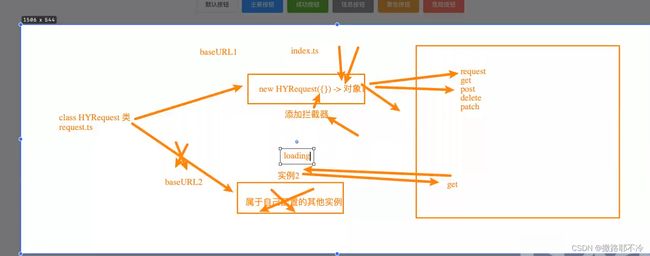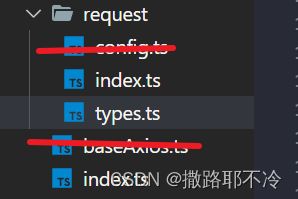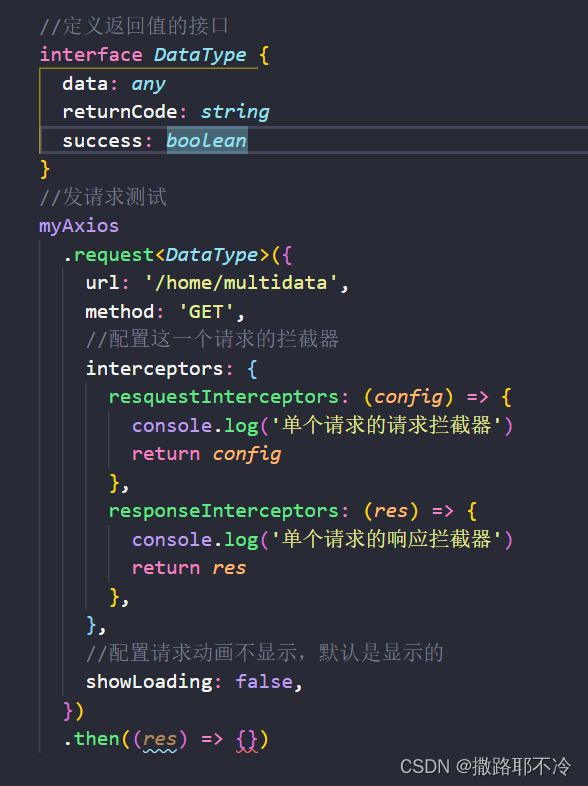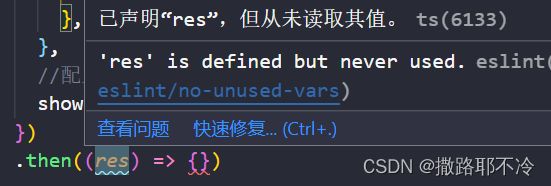4-封装axios
源码github连接:baojinghui/MyAxios (github.com)
1,为什么要封装axios ,因为当一个库不维护时,便于在封装的地方把不维护的库替换掉
2,因为axios返回的是一个实例对象,所以只能这一个实例上修改。但是我们的接口有两种baseUrl,就可以通过封装,不同的接口创建新的实例去配置,不同实例互不干扰。
3,配置拦截器,给不同的实例配置不同的拦截器,支持以对象形式接受多个拦截器配置
4,一般情况下一个实例就够用了,在大行项目中可以使用到多个实例
目录结构:
类型声明:
/*------------------------- TS封装拦截器的接口 -------------------------------------*/
//导入axios的 实例的类型 请求参数的类型 响应数据的类型
import type { AxiosRequestConfig } from 'axios'
//扩展拦截器的类型,支持传入一个对象,对象中可同时传入多个回调,可以同时包含响应器和拦截器的配置
export interface MyInterceptors {
//请求拦截器和请求拦截器捕获错误的类型
resquestInterceptors?: (config: AxiosRequestConfig) => AxiosRequestConfig
resquestInterceptorsCatch?: (err: any) => any
//响应拦截器和响应拦截器捕获错误的类型
responseInterceptors?: (config: any) => any //AxiosResponse
responseInterceptorsCatch?: (err: any) => any
}
//类型扩展,把axios上的类型,扩展到自己定义的接口上,使请求参数支持传入一个对象
export interface MyRequestConfig extends AxiosRequestConfig {
interceptors?: MyInterceptors //扩展后的拦截器
showLoading?: boolean //是否显示加载动画
}
基于axios封装的类:
//封装一个axios的类,每次使用时生成一个新的实例,这样配置多种不同服务器请求的接口
import axios from 'axios'
//导入axios的 实例的类型
import type { AxiosInstance } from 'axios'
//导入扩展后的接口类型 和扩展后的请求参数类型
import type { MyInterceptors, MyRequestConfig } from './types'
//导入请求动画组件
import { ElLoading } from 'element-plus'
// 导入请求动画实例的类型,用于取消动画
import { LoadingInstance } from 'element-plus/lib/components/loading/src/loading'
//封装axios
class MyAxios {
instance: AxiosInstance //实例
interceptors?: MyInterceptors //拦截器
loading?: LoadingInstance //加载动画
showLoading?: boolean //是否显示请求的动画
//config的类型改为加了自己扩展后的类型:AxiosRequestConfig--->MyRequestConfig,
//上面会增加interceptors接口,支持同时传入多个拦截器,和接受是否显示动画的配置
constructor(config: MyRequestConfig) {
//每次调用instance都会产生一个新的实例,在新的实例上面配置新的baseurl等配置
this.instance = axios.create(config)
//保存一份传入的所有拦截器
this.interceptors = config.interceptors
//默认显示请求动画:showLoading默认为true
this.showLoading = config.showLoading ?? true
//使用实例身上的请求拦截器和响应拦截器的方法,把传入拦截器对象中的方法依次传入
this.instance.interceptors.request.use(
this.interceptors?.resquestInterceptors,
this.interceptors?.resquestInterceptorsCatch
)
this.instance.interceptors.response.use(
this.interceptors?.responseInterceptors,
this.interceptors?.responseInterceptorsCatch
)
//但是有些拦截器配置每个实例都会需要,
//如请求时的动画,需要全局配置,让每个实例中都存在,就直接使用axios上面的拦截器进行封装
this.instance.interceptors.request.use(
(config) => {
console.log('全局拦截成功')
//全局配置loading动画,拿下loading
if (this.showLoading)
this.loading = ElLoading.service({
lock: true,
text: '正在加载...',
background: 'rgba(0,0,0,0.5)',
})
return config
},
(err) => {
console.log('全局拦截失败')
return err
}
)
this.instance.interceptors.response.use(
(res) => {
setTimeout(() => {
this.loading?.close()
}, 1000)
console.log('全局响应成功')
const data = res.data
if (data.returnCode == '-1001') {
console.log('请求失败')
} else {
return data
}
},
(err) => {
console.log('全局响应失败')
this.loading?.close() //移除加载动画
if (err.response.status === 404) {
console.log('404错误信息')
}
return err
}
)
}
//封装request请求
//请求参数config要用自己扩展后的接口(MyRequestConfig),才支持传入对象形式的拦截器
request(config: MyRequestConfig): Promise {
return new Promise((resolve, resject) => {
//还可以给单个请求配置拦截器
if (config.interceptors?.resquestInterceptors) {
//如果存在说明配置了单个请求的拦截器,就把转换后的config返回给config继续处理
//config.interceptors.resquestInterceptors(config)返回的是一个处理过后的config
config = config.interceptors.resquestInterceptors(config)
}
//请求动画默认false,如果showloading为false,就是关闭请求动画
if (config.showLoading === false) {
this.showLoading = config.showLoading
}
//使用axios自身的request发请求
this.instance
.request(config)
.then((res) => {
//如果为真说明配置了单个请求的响应拦截器,就把转换后的res返回给res继续处理
//config.interceptors.resquestInterceptors(res)返回的是一个处理过后的res
if (config.interceptors?.responseInterceptors) {
res = config.interceptors.responseInterceptors(res)
}
//让动画显示,即使上面不显示动画的请求完也设置,这样不影响后面的动画显示
this.showLoading = true
resolve(res)
})
.catch((err) => {
this.showLoading = true
resject(err)
})
})
}
//封装get请求,就是再get内部调request
get(config: MyRequestConfig): Promise {
return this.request({ ...config, method: 'GET' })
}
//封装post请求,就是再post内部调request
post(config: MyRequestConfig): Promise {
return this.request({ ...config, method: 'GET' })
}
//封装delete请求,就是再delete内部调request
delete(config: MyRequestConfig): Promise {
return this.request({ ...config, method: 'GET' })
}
//封装patch请求,就是再patch内部调request
patch(config: MyRequestConfig): Promise {
return this.request({ ...config, method: 'GET' })
}
}
export default MyAxios
创建实例:
//配置MyAxios的实例并导出
import MyAxios from './request/index' //导入axios
import { BASE_URL, TIME_OUT } from '@/service/request/config' //导入环境变量
const myAxios = new MyAxios({
baseURL: BASE_URL,
timeout: TIME_OUT,
//可选,单个实例的拦截器
interceptors: {
resquestInterceptors(config) {
console.log('实例请求拦截成功')
return config
},
resquestInterceptorsCatch(err) {
console.log('实例请求拦截失败')
return err
},
responseInterceptors(res) {
console.log('实例响应拦截成功')
return res
},
responseInterceptorsCatch(err) {
console.log('实例请求拦截失败')
return err
},
},
})
//导出封装的实例
export default myAxios
发送请求演示:
得到的返回值是我们传入接口的类型



